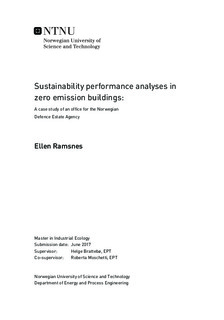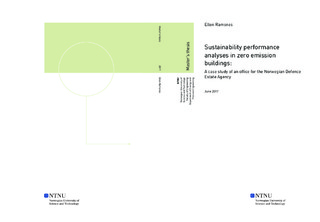| dc.description.abstract | Energy consumption in the building sector account for 40 % of the total energy use in Norway. One of the actions to lower the sectors impact on the climate change is to improve the energy efficiency in buildings and increase the use of renewable energy sources. Political incentives are taken to obtain a considerable reduction of CO2 -emissions. From 2020, all new buildings should be nearly zero energy buildings (nZEB), pursuant to the directive on Energy Performance of Buildings.
With a higher focus on the environmental impacts from products and processes, the demand for including sustainability analyses in the decision context under the construction planning increases. By taking advantage of life cycle analyses (LCA), the energy use and environmental impact connected to the different life stages of a building can be calculated.
In this case-study, the sustainability performance of a nearly zero emission building has been investigated. The owner is the Norwegian Defence Estates Agency, which is one of the main stakeholders in the construction sector in Norway. Due to their position, they want to investigate the value of constructing low-energy buildings compared to standard buildings.
Five sustainability performance analyses of the office with different material solutions have been conducted in SimaPro. The performance of the building is computed for:
Alternative 1:as built (with low-CO2 emission concrete).
Alternative 2: as built, but with normal concrete.
Alternative 3: as built, but with timber bearing structures.
Alternative 4: as built, but timber bearing structures, timber façade and wooden windows.
Alternative 5: as built and with PV panels attached to the façade facing south
The analyses include the following life cycle phases: construction, use phase, transport and replacements. Through LCA certain chosen environmental indicators were quantified, i.e. Global Warming Potential (GWP), Cumulative Energy Demand (CED) and Net Present Costs (NPC). Through life cycle costing (LCC) methodology, the life cycle costs related to the different building alternatives have been calculated.
For the performed analyses, the results reveal that the main differences between the alternatives are found in the GWP. Some alternatives had less CED than the others, but no big savings were found when comparing the NPC. Alternative 4 performed best in terms of GWP with an annual emissions of 7.5 kg CO2 eq. per m2. Alternative 5 used had the lowest CED, 56 kWh/ m2yr. The construction phase and operation had the greatest contribution to the analysed indicators. | |

